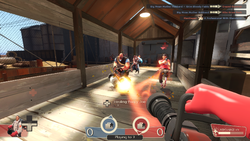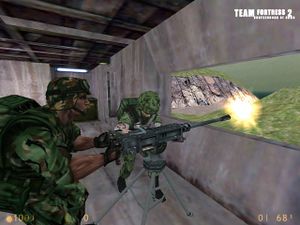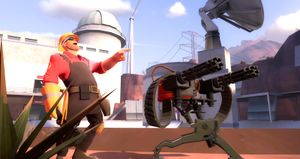팀 포트리스 2
| 이 페이지는 한국어로 번역 중입니다. 한국어를 능숙하게 하신다면 토론 페이지에 글을 남기거나 문서 역사를 참고하여 문서 번역에 참여한 번역가들과 이를 상의하시기 바랍니다. |
| 팀 포트리스 2 | |
|---|---|

| |
| 기본 정보 | |
| 출시일: |
|
| 개발사 | |
| 발행사: | |
| 배급사: |
일렉트로닉 아츠/스팀 |
| 엔진: | |
| 장르: |
1인칭 슈팅 게임 |
| 모드: |
멀티 플레이 |
| 디자이너: |
John Cook, Robin Walker |
| 이용가 등급: |
|
| 플랫폼: |
윈도, 엑스박스 360, 플레이스테이션 3, 맥 |
| 미디어: |
다운로드, DVD, 블루레이 디스크 |
| 요구 사항: |
|
팀 포트리스 2는 팀 기반의 멀티플레이 1인칭 슈팅 게임이다. 밸브 코퍼레이션에 의해 오렌지 박스에 포함된 게임 중 하나로 개발되었다. 2007년에 마이크로소프트 윈도, 엑스박스 360, 플레이스테이션 360으로 출시되었으며, 2008년에 단독 패키지로 출시되었다.
이 게임은 본래 1998년 슈팅 게임 퀘이크의 모드 팀 포트리스의 후속작으로 발표되었으나, 그 이후로 수많은 콘셉트와 디자인을 거쳐 왔다. 1999년, 모드 팀 포트리스를 벗어나 밸브의 하프-라이프의 모드 팀 포트리스 클래식으로 등장하여 더욱 사실적이고 군사적인 스타일의 게임을 보여주었다. 하지만 게임의 디자인은 9년의 개발 기간과 게임 엔진의 교체로 인해 상당히 많이 바뀌었다. 팀 포트리스 2로 나타난 결과물은 원작인 팀 포트리스 와 팀 포트리스 클래식에 더욱 닮아 있으며, 인크레더블 등의 당시 유행했던 컴퓨터 그래픽 영화와 같이 J. C. Leyendecker, Dean Cornwell, Norman Rockwell 등의 작품에 기반한 카툰 풍의 시각적 스타일을 자랑한다.
게임 개발 도중 6년간의 공백기는 한때 이 게임을 나올 가능성이 없는 게임으로 알려지게 만들기도 하였고, 정기적으로 Wired News의 올해의 나올 가망성 없는 제품들 목록에 등장하게 만들기도 하였다. 하지만 발매 이후로 팀 포트리스 2는 평론가들의 칭송과 수 많은 상을 수상해왔다.
목차
게임 플레이
전작과 마찬가지로, 팀 포트리스 2는 목표물을 놓고 싸우는 두 팀을 기반으로 만들어졌다. 이 두 팀은 각각 철거 회사와 건설 회사를 의미한다. 곧, RED팀은 Reliable Excavation Demolition의 약자이며, BLU팀은 Builders League United의 약자이다. 플레이어는 각자 장단점을 가지고 있는 9가지의 병과를 고를 수 있다. 비록 몇몇 병과의 능력은 이전의 팀 포트리스시리즈와는 다르게 바뀌었지만, 각 병과의 기본적인 요소는 같다.
팀 포트리스 2는 밸브 소프트웨어의 멀티플레이어 게임이다. 플레이어들의 상세 통계를 지원하는 게임으로는 처음이기도 하다. 이 통계 자료는 병과별로 플레이 시간, 평균 점수, 최대 점령, 목적 달성 등을 보여준다. (밸브 통계 참조.) 이렇게 끊임없이 집계는 통계는, 예를 들자면 한 라운드에 어느 한 플레이어가 입힌 피해의 양의 최고 기록에 얼마나 가까이 갔는지 등을 통해 얼마나 나아지고 있는가를 통계학적으로 보여준다. 또한 팀 포트리스 2는 수많은 도전 과제를 지원한다. 플레이어들은 일정 수의 킬을 일정 시간 안에 달성시키는 등의 특정한 임무를 성공시켜서 도전 과제들을 달성할 수 있다. 이후의 업데이트들로 인해 특정 병과 전용의 도전 과제가 새로 추가되었으며, 이러한 병과 전용 도전 과제는 달성 시 해당 병과에 새로운 능력 및 무기를 추가해준다. 달성된 도전 과제나 플레이한 게임의 통계는 해당 플레이어의 스팀 커뮤니티나 엑스박스 라이브 프로필 페이지에서 볼 수 있다.
맵
PC 버전의 경우, 이 게임은 밸브가 제작한 여러개의 공식 맵과 커뮤니티가 개발한 여러 맵을 포함하고 있다. 그러나, 콘솔 버전에는 밸브가 제작한 단 6개의 맵만 포함되어 있다. 공식 맵들은 주로 창고 사이에 숨겨진 비밀 기지나, 레이저 포나 미사일 발사 연구소와 같은 비현실적으로 강력한 무기와 같은 사악한 천재의 사고방식으로 꾸며져 있다. 또한 이러한 것들이 목표물의 역할을 하기도 한다.
플레이어가 어떤 맵에 처음으로 입장할 때 맵의 목표를 어떻게 완수할 지에 대한 안내 영상이 보여진다. PC에서의 인원 수 제한은 24명이나, 몇몇 서버에서는 최대 32명까지 늘어나기도 하였다. 엑스박스 360이나 플레이스테이션 3에서의 인원 수 제한은 16명이다.
개발
원작
1998년에 GoldSrc 엔진에 개발된 팀 팀 포트리스 소프트웨어가 - 로빈 워커와 죤 쿡 으로 이루어져 있다 - 처음으로 계약되기 전환되고 마지막으로 철처하게 밸브 사 에 의해 채택되는 팀 포트리스2에 진보, 발달을 위해 자유로운 모드 로 원래 계획해. 팀 포트리스 소프트웨어 의 활약으로; 개발진은 위로 이동하고, 시간 뿐 아니라 발행하기 때문에 게임은 조수 팬에 독립의, 소매 제품에, 기초가 팀의 자유로운 방출을 기대하여 반감기를 유일하게 구매했었던 팀 요새 선수의 다량 넘어서 승진되었다 팀포2. 일이 자유로운 팀 요새 고전으로 1999에서 풀어 놓인 게임의 간단한 클래식에서 시작한. 현저하게, 팀 요새 고전은 그것의 융통성의 지역 사회 그리고 기업에 공적으로 사용 가능한 반감기 소프트웨어 개발 장비 안에 한 예로 완전히 건축되었다. 워커 와 쿡은 벨브에 그들의 3 개월 계약상 제한에 의해 몹시 좌우되고, 지금 급속한 변성을 치루고 있던 그들의 디자인에 전임으로서 종사하고 있었다. 팀 포트리스 2는 힘를 가진 지휘관을 포함하여 명령 계층구조와 더불어 현대 도상 작전 연습, 이다;전장의 방식은, 적 영토 상공에 낙하산 투하, 네트 워크 음성 통신 및 수많은 다른 혁신적이다.
E3 1999
The new design was revealed to the public at the 1999 Electronic Entertainment Expo (E3), where it earned several awards including Best Online Game and Best Action Game. By this time Team Fortress 2 had gained a new subtitle, Brotherhood of Arms, and the results of Walker and Cook working at Valve were becoming clear. Several new and at the time unprecedented technologies on show: Parametric animation seamlessly blended animations for smoother, more life-like movement, and Intel's Multi-resolution mesh technology dynamically reduced the detail of on-screen elements as they became more distant to improve performance (a technique made obsolete by decreasing memory costs; today games use a technique known as level of detail, which uses more memory but less processing power). No release date was given at the exposition.
In mid-2000, Valve announced that development of Team Fortress 2 had been delayed for a second time. They put the news down to development switching to an in-house, proprietary engine that is today known as the Source engine. It was at around this time that all news ran dry and Team Fortress 2 entered its notorious six-year radio silence, which was to last until July 13, 2006. During that time, both Walker and Cook worked on various other Valve projects—Walker was project lead on Half-Life 2: Episode One and Cook became a Steam developer, among other tasks—raising doubts that Team Fortress 2 was really the active project that would be repeatedly described.
"Invasion" design

When the Half-Life 2 source tree was leaked in late 2003, two Team Fortress 2 models were included, along with direct references to the game in the source code. They consisted of an alien grunt and a very stylized, out-of-proportion human soldier. The code was interpreted by fans as making references to the Seven Hour War, an integral part of the Half-Life story; however, the two leaked player models did not resemble any known style from the Half-Life series.
The Source SDK was released with the Half-Life 2 source code, and also provided references to Team Fortress 2. Some code merely confirmed what was already believed, but other segments provided completely new information, such as the presence of NPCs in multiplayer matches, the possibility of the game taking place in the Half-Life 2 universe, fixed plasma gun and missile launcher emplacements, and more.
None of the leaked information appears to have had any bearing on today's version of the game. This iteration was mentioned in an August 2007 interview with Gabe Newell by GameTrailers and a September 2010 interview with PC Gamer, in which he mentions "Invasion" as being the second phase of Team Fortress 2's development under Valve Software.
Final design
The next significant public development occurred in the run up to Half-Life 2's 2004 release: Valve's Director of Marketing Doug Lombardi claimed that Team Fortress 2 was still in development and that information concerning it would come after Half-Life 2's release. This did not happen; nor was any news released after Lombardi's similar claim during an early interview regarding Half-Life 2: Episode One. Near the time of Episode One's release Gabe Newell again claimed that news on Team Fortress 2 would be forthcoming— and this time it was. Team Fortress 2 was re-unveiled a month later at the July 2006 EA Summer Showcase event.
Walker revealed in March 2007 that Valve had quietly built "probably three to four different games" before settling on their final design. Due to the game's lengthy development cycle it was often mentioned alongside Duke Nukem Forever, another long-anticipated game that has seen many years of protracted development and engine changes.
The beta release of the game featured six multiplayer maps, of which three contain optional commentary by the developers on the game design, level design and character design, and provide more information on the history behind the development.
Team Fortress 2 does not attempt the realistic graphical approach used in other Valve games on the Source engine such as Half-Life 2, Day of Defeat: Source and Counter-Strike: Source. Rather, it uses a more stylized, cartoon-like approach "heavily influenced by early 20th century commercial illustrations.". The effect is achieved using a special Valve in-house rendering and lighting technique making extensive use of 'Phong shading'. The development commentary in the game suggests that part of the reason for the cartoonish style was the difficulty in explaining the maps and characters in realistic terms. The removal of an emphasis on realistic settings allows these questions to be sidestepped. The game debuts with the Source engine's new dynamic lighting, shadowing and soft particle technologies, among many other unannounced features, alongside Half-Life 2: Episode Two. Team Fortress 2 was also the first game to implement the Source engine's new Facial animation 3 features.
The art style for the game was inspired by J. C. Leyendecker, as well as Dean Cornwell and Norman Rockwell. Their distinctive styles of strong silhouettes and shading to draw attention to specific details were adapted in order to make the models distinct, with a focus on making the characters' team, class and current weapon easily identifiable. Silhouettes and animation are used to make the class of a character apparent even at range, and a color scheme that draws attention to the chest area brings focus to the selected weapon.
Maps are designed with a neutral space between two bases. They are archetypal spy fortresses, but disguised as inconspicuous buildings to give plausibility to their close proximities. The maps have little visual clutter and stylized, almost impressionistic modeling, to allow enemies to be spotted more easily. The impressionistic design approach also affects textures, which are based on photos that are filtered and improved by hand, giving them a tactile quality and giving Team Fortress 2 its distinct look. The bases are designed to let players immediately know where they are. The RED base uses warm colors, natural materials and angular shapes, while the BLU base uses cool colors, industrial materials and orthogonal shapes.
Release
During the July 2006 Electronic Arts press conference, Valve revealed that Team Fortress 2 would ship as the multiplayer component of Half-Life 2: Episode Two. A conference trailer demonstrated the game's new graphical style featuring all of the original Team Fortress classes, pointed towards a more light-hearted and whimsical visual style as opposed to the dark, somewhat more traditional military simulation that had originally been shown. Gabe Newell, the managing director of Valve, said that their goal was to create "the best looking and best-playing class-based multiplayer game."
A beta for Team Fortress 2 was released via Steam on September 17 2007 for customers who pre-purchased The Orange Box and for those who activated their Black Box coupon, which was included with the ATI HD 2900XT Graphics cards. In addition to The Orange Box customers, LAN gaming centers using the 'Steam for Cafe' system have the game installed and ready to play.
Team Fortress 2 was released October 10 2007 as both a standalone product via Steam and at retail stores as part of The Orange Box, a compilation pack priced at each gaming platform's standard price. The package also contains Half-Life 2, Half-Life 2: Episode One, Half-Life 2: Episode Two and Portal. Valve offered The Orange Box at a $5 discount for those who pre-purchased it via Steam before the October 10 release, as well as the opportunity to participate in the final beta test of Team Fortress 2.
Critical reception
- 1UP: 9.0/10 (Windows) 1UP TF2 (Win) Review)
- EuroGamer: 9/10 (Windows) EuroGamer TF2 (Win) Review)
- GameSpy: 5/5 (Windows) GameSpy TF2 (win) Review)
- IGN: 8.9/10 (Windows)
- PCGamer UK: 9.4/10 (Windows) PC Gamer UK TF2 (WIN) Review)
- GamerNode: 9.0/10 (Windows) Gamernode TF2 (Win) Review)
- GameDaily: 9.0/10 (Windows) GameDaily TF2 (Win) Review)
- Metacritic: 92% (Windows)
- Gamerankings: 96.2% (Windows) 96.1% (Xbox 360) 87.7% (PlayStation 3)
Team Fortress 2 was very well received by critics and consumers alike. Charles Onyett of IGN awarded Team Fortress 2 an 8.9/10, praising the quirky graphics and fun atmosphere, but criticizing the lack of extra content, like bots, as well as the removal of class-specific grenades, which were one of the defining features of the original Team Fortress. By contrast, PC Gamer UK praised Team Fortress 2 for removing the grenades, continuing to compliment Valve Software for the unique nature of each of the game's characters. Despite some mild criticism over map navigation and the Medic class, PC Gamer UK awarded the game 94%. X-Play awarded The Orange Box with its highest rating (5/5) with nothing but good things to say about Team Fortress 2. Review aggregation site Metacritic ranks Team Fortress 2 as having received "universal acclaim", with an average critic review of 92%, based on 12 reviews by game critic sites, and a 9.6/10 rating based on user ratings. As of January 21, 2008, The Orange Box has a GameRankings score of 96.2% on the Xbox 360, making it tied for the the highest ranked Xbox 360 game, and a score of 96.2% on the PC.
Awards
Team Fortress 2 has won several awards since its release. In its "Best of 2007" awards, IGN.com honored the game with an award for "Best Artistic Design" for PC. Additionally, Team Fortress 2 received awards for "Best Multiplayer Experience (PC)" and "Best Artistic Direction (PC)" from 1UP.com in its 2007 editorial awards. The game also won "Best Multiplayer Game of the Year" both on PC and on any platform in GameSpy's 2007 Game of the Year awards along with an award for "Most Unique Art Style".
외부 링크
- The Team Fortress 2 page at the official site of The Orange Box.
- Valve Software official site.
- The Official Team Fortress 2 Blog
Major game updates (oldest to newest):
- The Gold Rush Update (04/29/2008)
- The Pyro Update (6/19/2008)
- A Heavy Update (8/19/2008)
- The Scout Update (2/24/2009)
- The Sniper vs. Spy Update (5/21/2009)
- Classless Update (8/13/2009)
- Hallowe'en Special (10/29/2009)
- WAR! Update (12/17/2009)
- 119th Update (04/29/2010)
- The Mac Update (06/10/2010)
- The Engineer Update (07/08/2010)
- The Mann-Conomy Update (09/30/2010)
- Scream Fortress Update (10/27/10)



